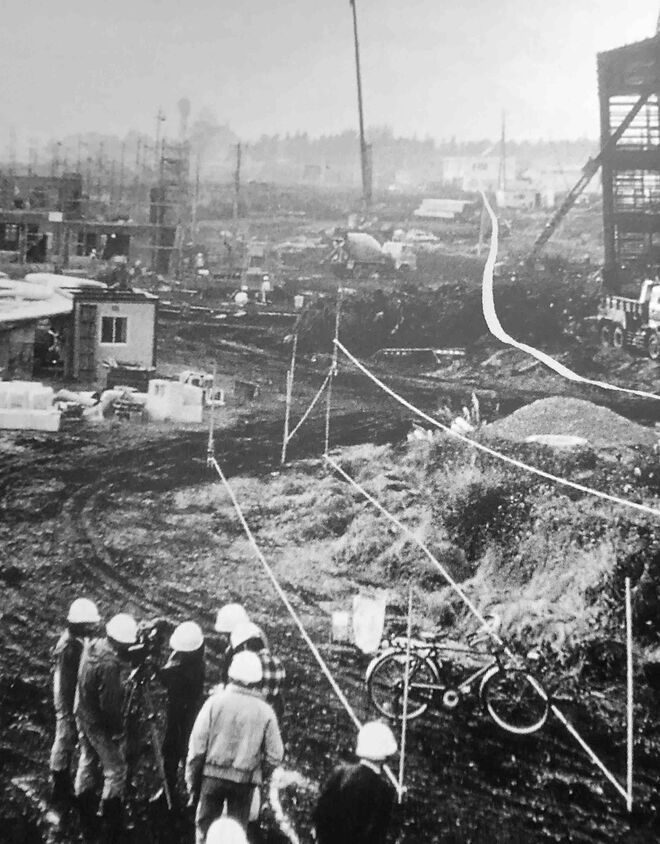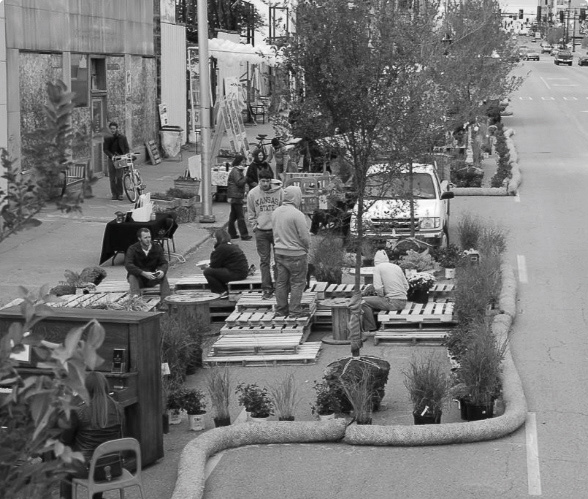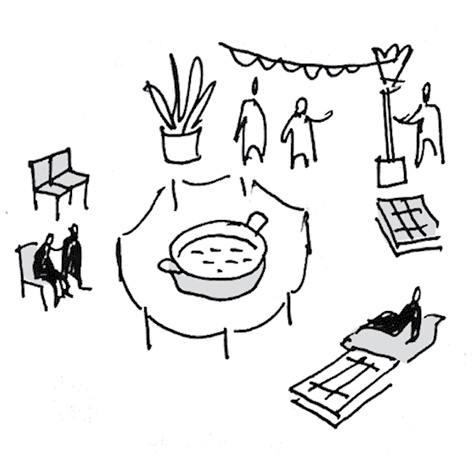16.4. Community Mockup
Aus Pattern Language Wiki
(Weitergeleitet von .../Community Mockup)
In making urban changes to the Walkable Streetscape or other features, it is helpful to be able to do temporary structures that help to mock up the results.
Problem-statement: How can changes to the neighborhood design be tested and accepted by stakeholders before commitments are made and significant expenditures are committed?
Discussion: An approach that has proved successful is to create mockups of the changes that are proposed. These can be done with large stakes, flags, styrofoam panels, colored string stretched on the ground, or temporary paint on the surface of pavement areas.
One example is known as the Better Block project. Where changes are proposed to the streetscape to enhance pedestrian quality, proponents come in and make temporary and reversible changes, using paint, planters, seating, and other temporary changes. These can then be viewed and assessed — often with enthusiastic results, and commitment to more permanent changes.
This is more than just a tactical way to persuade stakeholders of the benefits of a proposed design — though it is that too. It is actually a sophisticated method of collective intelligence in design. The results of rapid trial and error in a community mockup can lead the way to the most adaptive new structures that could be erected, far better than any professional design carried out on a remote computer screen. Designs checked and adjusted on site by such simple methods will work best in actual use after they are built, because an enormous number of factors have already been tested.¹
Community residents create a mockup of streetscape improvements in Kansas City.
A related approach is to use augmented reality to create images that are visible on smartphones and other GPS-sensitive devices — see Augmented Reality Design. In the same way, different design ideas can be generated and tested very quickly, allowing a group of stakeholders to view them in real time.
Therefore:
Use community mockups to simulate the changes that are proposed, using temporary materials such as stakes, fabric, washable paint, and movable elements, or using augmented-reality technology.
Use Augmented Reality Design tools to assist residents with visualization and collaboration in developing design ideas. …
¹ An example of this process in practice is given in Radywyl, N., & Biggs, C. (2013). Reclaiming the commons for urban transformation. Journal of Cleaner Production, 50, 159-170.
Mehaffy, M. et al. (2020). COMMUNITY MOCKUP (pattern). In A New Pattern Language for Growing Regions. The Dalles: Sustasis Press. Available at https://pattern-language.wiki/.../Community_Mockup
SECTION I:
PATTERNS OF SCALE
1. REGIONAL PATTERNS
Define the large-scale spatial organization…
1.4. 400M THROUGH STREET NETWORK
2. URBAN PATTERNS
Establish essential urban characteristics…
3. STREET PATTERNS
Identify and allocate street types…
4. NEIGHBORHOOD PATTERNS
Define neighborhood-scale elements…
5. SPECIAL USE PATTERNS
Integrate unique urban elements with care…
6. PUBLIC SPACE PATTERNS
Establish the character of the crucial public realm…
7. BLOCK AND PLOT PATTERNS
Lay out the detailed structure of property lines…
8. STREETSCAPE PATTERNS
Configure the street as a welcoming place…
9. BUILDING PATTERNS
Lay out appropriate urban buildings…
10. BUILDING EDGE PATTERNS
Create interior and exterior connectivity…
10.1. INDOOR-OUTDOOR AMBIGUITY
SECTION II:
PATTERNS OF MULTIPLE SCALE
11. GEOMETRIC PATTERNS
Build in coherent geometries at all scales…
11.2. SMALL GROUPS OF ELEMENTS
12. AFFORDANCE PATTERNS
Build in user capacity to shape the environment…
13. RETROFIT PATTERNS
Revitalize and improve existing urban assets …
14. INFORMAL GROWTH PATTERNS
Accommodate “bottom-up” urban growth…
15. CONSTRUCTION PATTERNS
Use the building process to enrich the result…
SECTION III:
PATTERNS OF PROCESS
16. IMPLEMENTATION TOOL PATTERNS
Use tools to achieve successful results…
16.2. ENTITLEMENT STREAMLINING
16.3. NEIGHBORHOOD PLANNING CENTER
17. PROJECT ECONOMICS PATTERNS
Create flows of money that support urban quality…
17.4. ECONOMIES OF PLACE AND DIFFERENTIATION
18. PLACE GOVERNANCE PATTERNS
Processes for making and managing places…
18.3. PUBLIC-PRIVATE PLACE MANAGEMENT
19. AFFORDABILITY PATTERNS
Build in affordability for all incomes…
19.1. INTEGRATED AFFORDABILITY
20. NEW TECHNOLOGY PATTERNS
Integrate new systems without damaging old ones…
20.2. RESPONSIVE TRANSPORTATION NETWORK COMPANY


